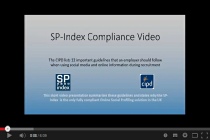
Call us today 0845 177 0700


RELATED ARTICLES






HEALTH & SOCIAL CARE -
The Health & Social Care industry is increasingly using Online Social Profiling to
enhance standards of recruitment and to strengthen pre-
BACKGROUND
Recent legal cases in the UK have highlighted that for decades institutional abuse has been a problem within the health and social care industry. Once exposed, the social and financial costs as well as damage to brand are phenomenal
The number of recognised vulnerable adults in need of care is increasing year on
year and sadly the percentages of those being ill-
- 39% of known abuse is caused by healthcare professionals in a patient's own home
- 36% is suffered within care homes
- 31% of overall abuse is caused directly by healthcare professionals
[Source: Report published by the Health & Social Care Information Centre]
HOW ONLINE SOCIAL PROFILING IS POSITIVELY INFLUENCING CARE QUALITY STANDARDS
Online Social Profiling looks into the individual's online social media and networks in order to identify risk associated with behavioural traits leaning towards violence and threatening behaviour, racism, discrimination and harassment, bullying, abuse and illegal activity.
For simplicity, let's refer to those individuals with these negative traits as 'Beta' workers.
The result of 18 months of research by the SP-
Responsible healthcare organisations deploy Online Social Profiling as part of their
employee pre-
The Health and Social Care industry benefits from a very specific pre-
The SP Index team are thought leaders in Online Social Profiling and are the UK's leading supplier of compliant profiling. If you would like further information about Online Social Profiling or wish to apply your own situation to our benefits calculator in order to evaluate your Return on Investment, please contact:
E: sarah.poynton@sp-
T: 0845 177 0700
Feel free to share your feedback on this article @SP_index and include the hash tag #onlinesocialprofiling.
www.linkedin.com/in/sarahpoynton
ENJOYED THIS POST?
Sign up for our newsletter to receive a summary of all new posts from the team at
the SP-
BENEFITS CASE EXAMPLE 1 -
Let’s use an example for a typical private healthcare group in the UK -
Assuming a replenishment level of 10%, this would result in 100 new recruits each
year. According to our database of historic profile results, 1 in 10 recruits will
receive a ‘red light’ status warning -
This means that the healthcare provider would be bringing into their business an estimated 10 Beta employees every year who are likely to show signs of undesirable behavioural traits.
The HOBRA check would identify these BETA candidates and allow the healthcare provider to prevent future risk of abuse
Assuming that recruiting managers spend a prudent 30mins looking into their online
accounts of every recruit -
95% less time will be spent carrying out online checks for 100% recruitment coverage
The healthcare will become fully compliant with HR legal and ethical guidelines and elements of discrimination will be removed
Great talent will no longer be inadvertently or otherwise overlooked and the standard of recruitment will be maintained or even improved
Of course, if we assumed that the healthcare provider was not checking any staff at all, this leaves an evident gap in the screening process and the provider risks 10 Beta workers entering the business.
Conclusion: Online Social Profiling would eliminate or at least minimise the number of Beta candidates entering the business and as a result improve the quality of care.
BENEFITS CASE EXAMPLE 2 – HOW DO YOU FANCY A LEAD ROLE ON PANORAMA?
During 2014 evidence of abuse in care homes was revealed by a whistle blower on Panorama. The care home featured on the programme had been deemed 'excellent' by the CQC yet on watching this program many regarded the treatment of these vulnerable adults as despicable acts of mental and physical bullying.
According to Abelite Consulting Ltd (consultants in cost and change management programmes) the total financial cost to the care company mentioned would have exceeded £250,000, excluding the social cost to victims, their families and the innocent care workers who were unfairly associated to the incident. It also excludes the downstream impact of future lost revenues as a result of brand damage – a phenomenal impact which could have been avoided with a simple HOBRA check on staff.
HOBRA checks minimise the risk of a whistle blower incident as a result of abuse by a ‘Beta’ worker making headlines – a situation which could cost hundreds of thousands £££
The loss of future revenue streams due to the brand damage could also run into hundreds of thousands £££ over several years
Conclusion: By filtering out Beta workers, Online Social Profiling dramatically reduces the risk of a whistle blower incident occurring. The cost impact of an incident is disproportionately high compared to the price of HOBRA checks. Avoiding just 1 such incident would pay for checks on all recruits for more than 10 years!
BENEFITS CASE EXAMPLE 3 – YOUR WORKERS ARE POTENTIALLY A SINGLE POINT OF FAILURE TO YOUR MOST IMPORTANT CARE AND SAFETY OBJECTIVES
Healthcare units are physically designed to provide protection for the vulnerable
-
However, this also means that a member of staff represents what is potentially a single point of failure towards meeting the overall care and safety objectives and standards.
Front-
Given the number of staff involved and the potential ‘points of failure’, as well
as the importance to ensure that staff working in the environment do not present
a Trojan horse style risk, stringent pre-
Of course, technology and operational supervising & monitoring procedures help to minimise the risks, but there is no doubt that every possible procedure should be implemented to ensure care and safety standards are upheld or improved.
Online Social Profiling is a new and innovative way to assess the behaviours of individuals before they are given responsibility for safeguarding roles. This sophistication was simply not possible in the past but it is now an affordable and cost effective tool at the fingertips of Healthcare providers.
Some questions for the Healthcare provider’s CFO to consider:
How would you measure the social or financial cost to an abused patient and their family as a result of a ‘Beta’ worker uncaringly allowing unauthorised persons into a restricted area?
What would be the social or financial cost incurred when a patient suffers abuse due to an item or substance being uncaringly allowed through a checkpoint, or even worse being supplied directly by a ‘Beta’ worker to the patient?
What is clear is that for such a minor investment it’s no wonder that Healthcare
providers are adopting Online Social Profiling to enhance and modernise their pre-
In short, the HOBRA is about Healthcare organisations filling a current gap in pre-
Conclusion: Online Social Profiling will identify in advance those Beta workers who may not be suitable for ‘checkpoint’ roles. This will minimise the number of Beta candidates entering the business and as a result improve the quality of care.
BENEFITS CASE EXAMPLE 4 – COST AVOIDANCE AND EFFICIENCY -
Let’s use the same case example as above. HOBRA checks deliver an added benefit of reducing the number of disciplinary actions. Assuming the Beta candidates have been allowed into the organisation, and that 67% are found to carry their negative online behaviours into the workplace, this means that the for 100 recruits the HR team and line managers will need to handle 7 new Beta disciplinary cases every year. This is a cost and inefficiency that could possibly have been avoided.
Russell HR Consulting Ltd (specialists in legal and disciplinary cases involving
social media) state that just handling the disciplinary process for each Beta case
costs a business an average of £18,000 – management time, unfair dismissal claims,
re-
Applying our example, for 7 Beta cases the cost would equate to an astonishing £126,000 (an average of £1,260 per recruit assuming 100 new employees per year), before tribunal costs.
CFO news -
Significant cost avoidance and ROI will be achieved (on average £1,260 per recruit) from profiling new staff and engaging early & openly with Beta candidates
Improved business focus for HR and line managers with a significant reduction in the number of disciplinary action and unfair dismissal claims
Combining the implementation of Online Social Profiling with upgraded staff policies to reflect social media use and screening delivers the added benefit of providing a stronger foundation for smooth handling of incidents involving misuse of social media by employees. Over time, the mutual culture, acceptance, and expectations between employer and employee become aligned and a smooth relationship with social media will exist into the future.
Cultures, values and expectations between employer and employees become aligned
-
Conclusion: Online Social Profiling encourages the modernisation of staff policies
to reflect up-
FINAL CONCLUSION
Online Social Profiling is a fully compliant tool that generates significant benefits to the Health and Social Care industry, delivering efficiency improvements, an innovative way to predict future risks to the care and safety of stakeholders, and high Returns on Investment £££.
It is no wonder that within such an important and constantly scrutinised industry, organisations are increasingly adopting such an innovative tool.
The cost to an abused patient is unquantifiable -

